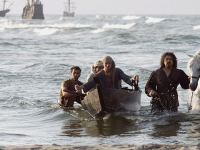Separating the myth of the pre-European Americas from the what the evidence actually shows - certainly not the history I learned in high school, or even college.
America Before Columbus
History books traditionally depict the pre-Columbus Americas as a pristine wilderness where small native villages lived in harmony with nature.
But scientific evidence tells a very different story: When Columbus stepped ashore in 1492, millions of people were already living there. America wasn’t exactly a New World, but a very old one whose inhabitants had built a vast infrastructure of cities, orchards, canals and causeways.
The English brought honeybees to the Americas for honey, but the bees pollinated orchards along the East Coast. Thanks to the feral honeybees, many of the plants the Europeans brought, like apples and peaches, proliferated. Some 12,000 years ago, North American mammoths, ancient horses, and other large mammals vanished. The first horses in America since the Pleistocene era arrived with Columbus in 1493.
Settlers in the Americas told of rivers that had more fish than water. The South American potato helped spark a population explosion in Europe. In 1491, the Americas had few domesticated animals, and used the llama as their beast of burden.
In 1491, more people lived in the Americas than in Europe. The first conquistadors were sailors and adventurers. In 1492, the Americas were not a pristine wilderness but a crowded and managed landscape. The now barren Chaco Canyon was once covered with vegetation. Along with crops like wheat, weeds like dandelion were brought to America by Europeans.
It’s believed that the domestication of the turkey began in pre-Columbian Mexico, and did not exist in Europe in 1491. By 1500, European settlers and their plants and animals had altered much of the Americas’ landscape. While beans, potatoes, and maize from the Americas became major crops in continental Europe.

No comments:
Post a Comment